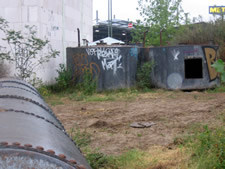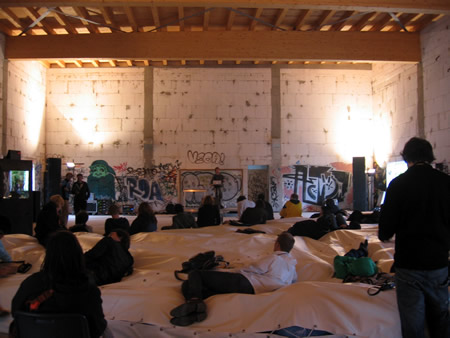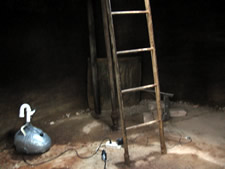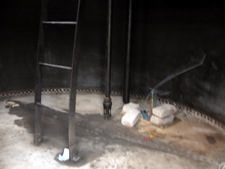Mok mok jaha für das kleine in Berlin
(Tuned City, Berlin _vi)
(( --> [ _o ] [ _one. ] [ _two. ] [ _three. ] [ _four. ] [ _five. ] [ _six. ] || [ found ] ))
february 07, 2009.
Over the past couple of months I have posted several articles (see the
list with links just after the title) that relate my adventures early july
of last year, when I joined Rinus van Alebeek for das kleine and
Tuned City, in the German city
of Berlin. Regular viewers will recall how the two of us tramped
from Neukölln to Mitte, and back again, tuning the city at a pace quite
different from that of the challenging and ambitious 'exhibition and conference
project' that was going on.
I also told you already how on saturday july 5th, the
final day of Tuned City, we had our own little sideshow in the almost
but not quite yet finished Cake & Coffee Records (shop and
gallery) in the Weserstraße in Neukölln, with presentations and performances from Ben
Roberts who flew in from Madrid and the Soinu Mapa boyzz from the Basque
Country. That was « das kleine, Intiem ». With the
little audience and artists that joined us there, we sat outside on the
pavement. We talked and drank in the warmth of an early summer night, like
cowboys and indians around a prairie campfire.
Much that I wanted to tell about that fine busy week in Berlin, if not most, by now has been told.
But there is one day that I did not yet write about. I kept it for the end. It was the day
that das kleine was on the Tuned City bill - very much the reason for me being in Berlin in the first place.
It was friday, july 4th.
It was also the one single day that week that the temperature suddenly dropped; the day that gray clouds came over Berlin and gave way to rain ... By some misfortunate twist of fate - or because it was meant to be - such was the day that « das kleine@Tuned City » was to happen. It had been planned as an open air event, on the premises of the former Wriezener Bahnhof in Friedrichshain (not far from the Kunstraum Takt, which had been das kleine's headquarters during its second edition, back in 2007).
 Of
course we went there walking, but only after Rinus had finished watching
the day´s episode of Sturm
der Liebe. Underway he enthusiastically summarized the soap's three
unnerving quarters of an hour. Thus I learned that Sania was in
shock because Gregor demanded that she stay away from Jana,
while Alfons lost his wallet in which he kept Hildegard's
lottery ticket; also, Simon called Gregor to account,
upon which Gregor admitted that in fact Sania's dreams
frighten him, very, very much; and when Jana went to see Sania
to apologize for Gregor's behavior, she suddenly started having
terrible abdominal pains; meanwhile André's double play is getting
him in ever deeper trouble: though he truly loves Charlotte, because
of Fiona he has to make believe that he is merely using her; he
therefore decided to help Ben get it on with Fiona ...
( * )
Of
course we went there walking, but only after Rinus had finished watching
the day´s episode of Sturm
der Liebe. Underway he enthusiastically summarized the soap's three
unnerving quarters of an hour. Thus I learned that Sania was in
shock because Gregor demanded that she stay away from Jana,
while Alfons lost his wallet in which he kept Hildegard's
lottery ticket; also, Simon called Gregor to account,
upon which Gregor admitted that in fact Sania's dreams
frighten him, very, very much; and when Jana went to see Sania
to apologize for Gregor's behavior, she suddenly started having
terrible abdominal pains; meanwhile André's double play is getting
him in ever deeper trouble: though he truly loves Charlotte, because
of Fiona he has to make believe that he is merely using her; he
therefore decided to help Ben get it on with Fiona ...
( * )
The Wriezener Bahnhof was in the other direction and much nearer to Neukölln than Mitte.
As said, it was a gray and coldish afternoon, windy and with something of a static wet drizzle wrapped around
the city, a drizzle though that - however much trying -
would probably never manage to become a rain ...
Near the Warschauerstraße we came upon some roadblocks: the police had closed
several of the side roads for all passing traffic. A couple of minutes
later we found out why: we were met by a group of some ten to
fifteen youngsters on bicycles coming down the road, dressed in left-/punk-ish
style, ringing their bells, waving a flag or two and shouting slogans protesting
the erection of a capitalist Mediapark
somewhere around there, along the Spree. Their sympathetic expression of
concern with the fate of the city of Berlin was boxed in
by a ridiculously disproportionate number of policemen and -cars, surrounding, conducting and observing
the minuscule group of protesting cyclists. These boys and girls were actually very
much like the afternoon's drizzle that beheld them: it was obvious right from the start,
that never in a lifetime their little row would manage to become a riot,
even less so a revolution ...
Friday july 4th, 2008, was a day without compromise. A day on which I knew that every single one of the facts that make up our universe is either hopelessly contingent, or a necessary link in an infinite chain being wrought with a purpose; that either everything is co-incidental, or nothing at all ... Both the drizzle and the row struck me as revealing images for das kleine's status as a part of our world in general, and as part of Tuned City in particular: for is it not so that to some purposes a persistent drizzle or an ongoing row will be far more effective than a hard rain or a short-lived riot ? It were thoughts as these that I found myself thinking, while Rinus and I crossed the Warschauerstraße and began walking down the Helsingforser Straße, following signs that led us along the fence to where we could enter the Wriezener Freiraum Labor, a vast piece of wasteland which used to be home to a railway station (the Wriezener Bahnhof) and where over the next years a public park is to be developed, in close collaboration with the people, schools, local shops and other activities in the neighborhood.
 |
 |
What had been put up there for now was sort of a rectangular box, a large barn, built from concrete blocks, topped with a surprisingly fine ceiling
made of solid wood ...
It had been meant to become the main production space for a theatre company, Derek Holzer told me, but for some reason that project had been
cancelled. "They'll take the roof off again soon as well," he said. But for now, it was still there, and providing the necessary shelter.
Given the continuing drizzle, the cold and the wind, « das kleine@Tuned City » would be
in, instead of out, there.

The audience got the City Mattress that you see in
the picture, a gigantic air-bed in the form of an equilateral-triangle with
sides of 15 meters. Maybe not the easiest thing to climb onto and move over,
but very comfortable indeed.
When we arrived, late in the afternoon, Chris
Watson was just about to start his lecture: "Listening to the city".
He told how earlier that week he had come at night with participants of
his Tuned City workshop to the Wriezener
Freiraum Labor, and how they hung out in the undergrowth outside to
record the city from there. But foremost - of course - to listen.
At that precise moment a train engine came by outside, passing slowly along
the rail tracks, at a mere couple of meters from the doorless holes in the wall.
The rumbling sound of the engine drowned that of Watson's voice, and he fell
silent for a while.
Lying on the soft air-bed, I closed my eyes. Then I fell
asleep, even before the train had fully passed and the speaker could resume his
talk.
When I woke up again, the Phonographic Arkestra was busy setting
up tables, installing laptops, paraphernalia, and getting ready to sound
check.

It was cold and windy, also inside the Wriezener barn. I crawled off the mattress, and went for a walk outside in the drizzle.
There was a lot to be heard and a lot to be seen.
The Composed City group (a collaboration between the dutch Lola landscape architects and the Staalplaat Soundsystem group, initiated by dutch sound cooker Geert-Jan Hobijn) undertakes the investigation and use of public space as an instrument. For Tuned City they played the Wriezener Freiraum Labor. Now that was a good choice, for I suppose there will not be an awful lot of such large stretches of near to no man's land left in the very heart of the city. It made for a fascinating sonic playground, this elongated future-park, lined on one side by a still functioning railway track and complex, and on the other side by a public street and housing.
In the couple of metal containers that remained lying around on the Freiraum, the Composed City group installed electro-mechanical sound making contraptions, using hammers, motors, modified vacuum cleaners.
 |
 |
Very effective, but also sort of an obvious thing to do.
Subtler and more interesting is Johannes
Steininger's Fly Paper. Bordering on the cynical, these wondrously
looking paper objects were meant to attract the Berlin house flies (Musca
Domestica) and other insects roaming the Wriezener Freiraum,
through sweet scented vapors coming from inside the paper cube. Insects crawling or flying by will become curious. They will try to get
to the source of the scent, and there is only one way in: through the cones.
Once having found their way inside, the little creatures will be trapped
there. Passers-by may approach the objects and bring their ears close to
the cones, and listen to the trapped insects humming and making other sounds
... As soon as the rain starts - and of course it always will, eventually
- the paper sculpture will get soaked by the water, and fall apart, thus
setting the insects (the musicians!) free again ...
Insects crawling or flying by will become curious. They will try to get
to the source of the scent, and there is only one way in: through the cones.
Once having found their way inside, the little creatures will be trapped
there. Passers-by may approach the objects and bring their ears close to
the cones, and listen to the trapped insects humming and making other sounds
... As soon as the rain starts - and of course it always will, eventually
- the paper sculpture will get soaked by the water, and fall apart, thus
setting the insects (the musicians!) free again ...
There was other stuff as well, such as loudspeakers installed in the undergrowth that played back recordings, in the spirit of William Burroughs' 1970s work and writing on audio viruses and the manipulation of reality through the embedding of field recordings in a given sonic environment ( ** ). That's applied schizophonia, really :-) ... I found it too cold, though, too wet and too windy to be able to really get into much of this at the time. But I did enjoy trying to imagine what I would have done, being given the opportunity to 'play' a such stretch of open space.
It was there, out on the open wasteland of the Wriezener Freiraum that das kleine should have been installed. But then, in the end, it was not.
Because of the bad weather, the « das kleine @ Tuned City »
show was taken into the barn, where also (at the end of an afternoon filled with
lectures, the viewing of John Grzinich's interesting location
sound films, and a whole series of Composed City presentations) a good & warm German meal was being served
to conference participants and collaborators.
Thus the barn - at least one half of it - first became a restaurant, before - a little later - it was put to use as a concert hall.
As a result « das kleine @ Tuned City » - to my surprise, I have to say - became the provider of an
after-conference-dinner soundscape, to which most of those present did not so much listen, as that they tolerated it while continuing
to drink, chat, gossip and network in the back of the barn.
This was a first surprise.
I am sure that the second one was part of the reason why the fieldrecordists presentations in the Wriezener Freiraum's barn turned into a "let's all chill-out with real sounds from nurture and nature!"-show. Every single one of the 'performers' was sitting there in the front side of the barn (be it ensemble or in turn), stubbornly looking down at the screen of a laptop computer that was playing back sounds in one way or another. Apart from the one action undertaken by the Soinu Mapa boys, and that I described in my previous Tuned City post, the presentations were completely void of whatever gesture attempting to reach out and communicate.
I am afraid I hardly ever before witnessed an event that was equally autistic.
This is bad news. For - we have discussed this in detail before - the eventual force of a public presentation of 'mixes of field recordings' lies in the possible multitude of stories it is able to evoke. This should be about communication, about the creation of a shared narrative experience. Now, in the intimacy of small scale presentations, where a majority of the audience arrives with the intent to listen and experience, the absence of gesture on the part of the presenter in general will not hinder communication, as the gesturality at such occasions will be implicit. The audience does not need to be reached, as the channels are already open, so to speak ... then and there (to once again paraphrase what the Duchess said to Alice) the "sounds can take care of themselves".
This was not the case on friday july 4th. A large part of the 'audience' present had not come with an intent to listen. And once das kleine was on its way, there was no-one among the presenters that attempted to grab their attention. As a result, and walking around the barn, also my attention was taken more and more by the undulating sound of chatting voices filling the space, and less and less by what was sent to the speakers from the presenters' hard drives ... Without directed attention, indeed, all of it sounded more or less ... the same.

|
No, of course I cannot (and will not) reproach the contributing artists that they are not performers. Their work does not necessarily ask for this (and it also can be a choice to not to perform). But (shared) communication does demand gesturality. Without, it will be impossible to establish a relation. As I suppose (and hope) it is the artist's intention to give (and not merely to receive), (s)he should be able to make this clear in a gesture of offering. When a such gesturality is not implicit, I do consider it up to the artist to try and make it explicit ... This was very much what would have been needed that evening in Berlin ...

|
Yes. Either everything is co-incidental, or nothing is: there may have been a reason for the fact that it was a dreary day with drizzling rain, and that as a result das kleine did not take place in the open of the Wriezener Freiraum. For now thinking back, it seems it would have been plain good-for-nothing to sit out there listening to (mostly) a mix of recordings made at different times at other 'opens', mingling with the real there and then sound of the Freiraum, without the slightest gesture from the side of the artists. For would that not have been but a mere addendum to Composed City's 'Playback' in the undergrowth, which had been doing something similar already all day long? Wouldn't I have wanted to listen that evening to the there and then of the Freiraum? I now do think that this is what « das kleine @ Tuned City » should have been: the listening to Berlin, outside on the Wriezener Freiraum, on friday july 4th, from 21h till 23h sharp, with all participating artists explicitly not playing their recordings from elsewhere (no break, no intermission).
That would have been special indeed, maybe not so much for the sounds per se, as for the gesture that would have established the relational act of the listening-together. It would have turned these two hours out there into a de facto narrative and composition, as forceful as it would have been volatile.
...
Those wanting to chat, gossip, network and drink would have stayed inside the barn.
...
It was not like not that. But I am confident that it will be.
There will be another time, another place.
...
[ Raudio 14 contains many hours of sound that I recorded during the my Tuned City stay in Berlin, july 2008, including seven radio-dicta-phonic pieces, each lasting precisely 28 minutes. The seventh and last in this series is called "The Wriezener Freiraum" and contains recordings of and around « das kleine @ Tuned City » . ]
[ Some of Rinus' words on the evening: 4th of july - Tuned Citizens ]
notes __ ::
(*) Sturm
der Liebe, Folge 649. [ ^ ]
(**) See also Mark Bain's Psychosonics and the
modulation of public space, in the Tuned
City reader. [ ^ ]
tags: das kleine, Berlin, field recordings, laptop, Sturm der Liebe
# .293.
comments for Mok mok jaha für das kleine in Berlin ::
|
Comments are disabled |